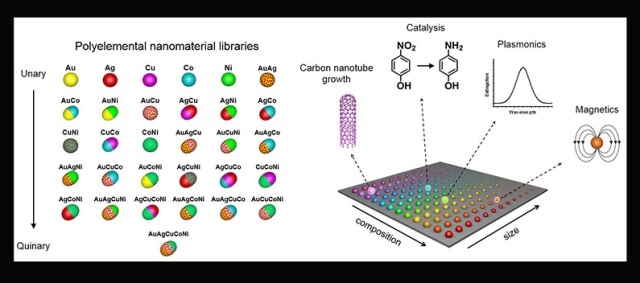Jun 27 2016
The discovery power of the gene chip is coming to nanotechnology. A tool to test millions (possibly billions) of different nanoparticles in a rapid manner and at a specific time in order to determine the best particle for a particular use has been developed by researchers from the Northwestern University.
 A combinatorial library of polyelemental nanoparticles was developed using Dip-Pen Nanolithography. This novel nanoparticle library opens up a new field of nanocombinatorics for rapid screening of nanomaterials for a multitude of properties. (Credit: Peng-Cheng Chen/James Hedrick)
A combinatorial library of polyelemental nanoparticles was developed using Dip-Pen Nanolithography. This novel nanoparticle library opens up a new field of nanocombinatorics for rapid screening of nanomaterials for a multitude of properties. (Credit: Peng-Cheng Chen/James Hedrick)
The electrical, optical, mechanical, structural and chemical properties change when the materials get smaller. This offers new possibilities. Identifying what nanoparticle size and composition are optimal for a specific application, like catalysts, electronic devices, biodiagnostic labels, and pharmaceuticals is a difficult task.
As scientists, we’ve only just begun to investigate what materials can be made on the nanoscale. Screening a million potentially useful nanoparticles, for example, could take several lifetimes. Once optimized, our tool will enable researchers to pick the winner much faster than conventional methods. We have the ultimate discovery tool.
Chad A. Mirkin, Northwestern University
Mirkin and his colleagues understood how to create combinatorial libraries of nanoparticles in an extremely controlled manner using a northwestern technique that leaves materials onto a surface. (A combinational library refers to a collection of systematically different structures that are encoded at particular sites on a surface). This work is featured in the June 24, 2016, issue of the journal Science.
According to Mirkin, the nanoparticle libraries are similar to a gene chip, where numerous different DNA spots are used to detect the presence of a toxin or disease. A number of reactions can be done at the same time, providing results within a few hours. Likewise, Mirkin and his group’s libraries would help researchers to quickly make and screen millions to billions of nanoparticles of varied sizes and compositions for required chemical and physical properties.
The ability to make libraries of nanoparticles will open a new field of nanocombinatorics, where size — on a scale that matters — and composition become tunable parameters. This is a powerful approach to discovery science.
Chad A. Mirkin, Northwestern University
Mirkin is the George B. Rathmann Professor of Chemistry in the Weinberg College of Arts and Sciences and founding director of Northwestern’s International Institute for Nanotechnology.
“I liken our combinatorial nanopatterning approach to providing a broad palette of bold colors to an artist who previously had been working with a handful of dull and pale black, white and grey pastels,” said Vinayak P. Dravid, co-author of the paper, and the Abraham Harris Professor of Materials Science and Engineering in the McCormick School of Engineering.
Mirkin and his colleagues created a collection of exceptional structures by varying all the elemental combinations of the five metallic elements — gold, cobalt, silver, nickel and copper. Previously, the scientists had demonstrated that particle diameter could also be varied purposely on the 1 to 100 nm length scale.
Although a few of the compositions could be found naturally, more than 50% of them have never remained on Earth. The nanoparticles are visualized like a collection of colorful Easter eggs, each element belonging to the palette, when visualized under high-powered imaging techniques.
Mirkin and his collegues used Dip-Pen Nanolithography to build the combinatorial libraries. Dip-Pen Nanolithography is a technique created at Northwestern in 1999, for depositing onto a surface single polymer “dots,” each carrying different metal salts. The scientists then heated these polymer dots, thereby shrinking the salts to metal atoms and creating a sole nanoparticle. The polymer dot size can be changed to the size of the last nanoparticle.
Mirkin said that this control of both composition and size of nanoparticles is very significant. The scientists used this tool to methodically produce a library of 31 nanostructures by making use of the five different metals.
To understand the size/shape and complex elemental compositions of the nanoparticles in the sub-nm range, the group approached Dravid, Mirkin’s friend and colleague. Dravid, founding director of Northwestern’s NUANCE Center, used his expertise to spatially map the compositional trajectories of the combinatorial nanoparticles with sophisticated electron microscopes of NUANCE.
Researchers can now study these nanoparticles and build various other useful combinatorial libraries made up of billions of structures that differ slightly in size and composition. These structures may turn out to be the future materials that power fuel cells, effectively harvest solar energy and transform it into valuable fuels, and catalyze reactions that utilize cheap feedstocks from the petroleum industry and convert them into high-value products which are useful in the pharmaceutical and chemical industries.
Mirkin is associated with the Robert H. Lurie Comprehensive Cancer Center of Northwestern University and co-director of the Northwestern University Center for Cancer Nanotechnology Excellence. He also is a professor of medicine, chemical and biological engineering, biomedical engineering and materials science at Northwestern.
The study was funded by GlaxoSmithKline, the Air Force Office of Scientific Research (award FA9550-12-1-0141) and the Asian Office of Aerospace R&D (award FA2386-13-1-4124).
The title of the paper is “Polyelemental nanoparticle libraries.” Apart from Mirkin and Dravid, the other authors of the paper are Peng-Cheng Chen (first author), Xiaolong Liu, James L. Hedrick, Zhuang Xie, Shunzhi Wang, Qing-Yuan Lin, and Mark C. Hersam, all from the Northwestern University.